Yufei Ding
Yggdrasil: Bridging Dynamic Speculation and Static Runtime for Latency-Optimal Tree-Based LLM Decoding
Dec 29, 2025Abstract:Speculative decoding improves LLM inference by generating and verifying multiple tokens in parallel, but existing systems suffer from suboptimal performance due to a mismatch between dynamic speculation and static runtime assumptions. We present Yggdrasil, a co-designed system that enables latency-optimal speculative decoding through context-aware tree drafting and compiler-friendly execution. Yggdrasil introduces an equal-growth tree structure for static graph compatibility, a latency-aware optimization objective for draft selection, and stage-based scheduling to reduce overhead. Yggdrasil supports unmodified LLMs and achieves up to $3.98\times$ speedup over state-of-the-art baselines across multiple hardware setups.
RoboVerse: Towards a Unified Platform, Dataset and Benchmark for Scalable and Generalizable Robot Learning
Apr 26, 2025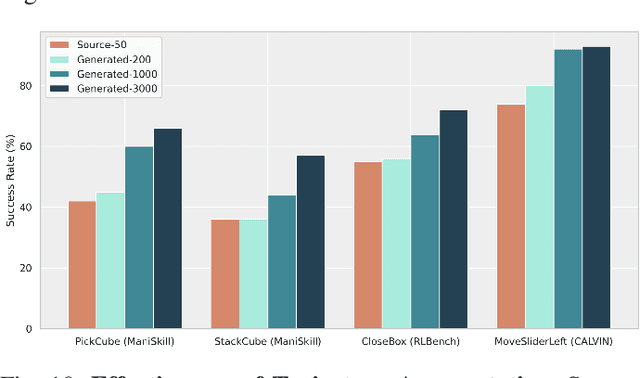
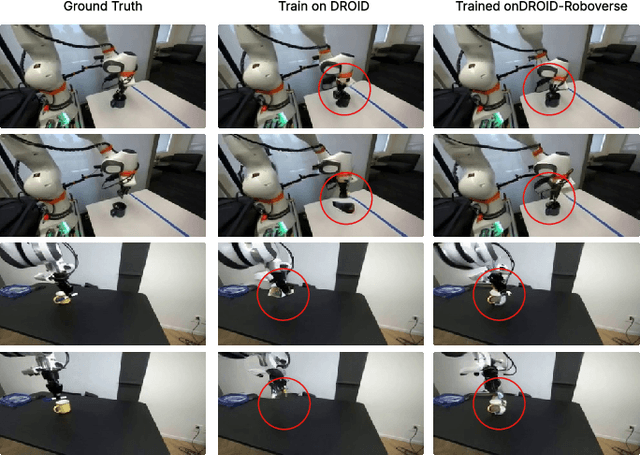
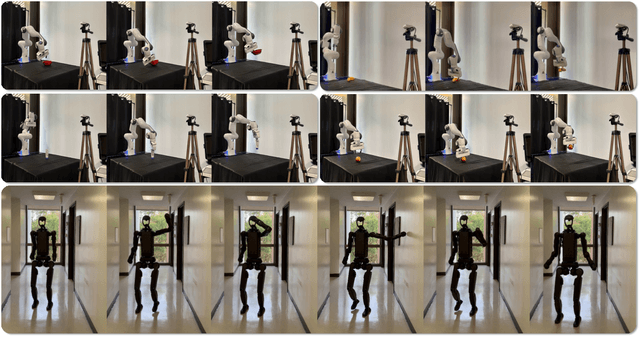
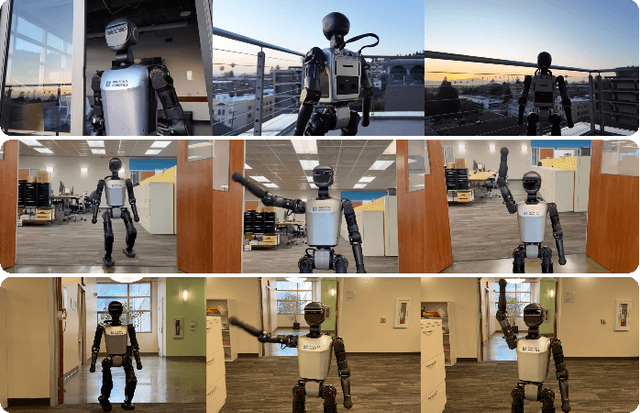
Abstract:Data scaling and standardized evaluation benchmarks have driven significant advances in natural language processing and computer vision. However, robotics faces unique challenges in scaling data and establishing evaluation protocols. Collecting real-world data is resource-intensive and inefficient, while benchmarking in real-world scenarios remains highly complex. Synthetic data and simulation offer promising alternatives, yet existing efforts often fall short in data quality, diversity, and benchmark standardization. To address these challenges, we introduce RoboVerse, a comprehensive framework comprising a simulation platform, a synthetic dataset, and unified benchmarks. Our simulation platform supports multiple simulators and robotic embodiments, enabling seamless transitions between different environments. The synthetic dataset, featuring high-fidelity physics and photorealistic rendering, is constructed through multiple approaches. Additionally, we propose unified benchmarks for imitation learning and reinforcement learning, enabling evaluation across different levels of generalization. At the core of the simulation platform is MetaSim, an infrastructure that abstracts diverse simulation environments into a universal interface. It restructures existing simulation environments into a simulator-agnostic configuration system, as well as an API aligning different simulator functionalities, such as launching simulation environments, loading assets with initial states, stepping the physics engine, etc. This abstraction ensures interoperability and extensibility. Comprehensive experiments demonstrate that RoboVerse enhances the performance of imitation learning, reinforcement learning, world model learning, and sim-to-real transfer. These results validate the reliability of our dataset and benchmarks, establishing RoboVerse as a robust solution for advancing robot learning.
SoFar: Language-Grounded Orientation Bridges Spatial Reasoning and Object Manipulation
Feb 18, 2025



Abstract:Spatial intelligence is a critical component of embodied AI, promoting robots to understand and interact with their environments. While recent advances have enhanced the ability of VLMs to perceive object locations and positional relationships, they still lack the capability to precisely understand object orientations-a key requirement for tasks involving fine-grained manipulations. Addressing this limitation not only requires geometric reasoning but also an expressive and intuitive way to represent orientation. In this context, we propose that natural language offers a more flexible representation space than canonical frames, making it particularly suitable for instruction-following robotic systems. In this paper, we introduce the concept of semantic orientation, which defines object orientations using natural language in a reference-frame-free manner (e.g., the ''plug-in'' direction of a USB or the ''handle'' direction of a knife). To support this, we construct OrienText300K, a large-scale dataset of 3D models annotated with semantic orientations that link geometric understanding to functional semantics. By integrating semantic orientation into a VLM system, we enable robots to generate manipulation actions with both positional and orientational constraints. Extensive experiments in simulation and real world demonstrate that our approach significantly enhances robotic manipulation capabilities, e.g., 48.7% accuracy on Open6DOR and 74.9% accuracy on SIMPLER.
DexGraspNet 2.0: Learning Generative Dexterous Grasping in Large-scale Synthetic Cluttered Scenes
Oct 30, 2024



Abstract:Grasping in cluttered scenes remains highly challenging for dexterous hands due to the scarcity of data. To address this problem, we present a large-scale synthetic benchmark, encompassing 1319 objects, 8270 scenes, and 427 million grasps. Beyond benchmarking, we also propose a novel two-stage grasping method that learns efficiently from data by using a diffusion model that conditions on local geometry. Our proposed generative method outperforms all baselines in simulation experiments. Furthermore, with the aid of test-time-depth restoration, our method demonstrates zero-shot sim-to-real transfer, attaining 90.7% real-world dexterous grasping success rate in cluttered scenes.
A Geometrical Approach to Evaluate the Adversarial Robustness of Deep Neural Networks
Oct 10, 2023



Abstract:Deep Neural Networks (DNNs) are widely used for computer vision tasks. However, it has been shown that deep models are vulnerable to adversarial attacks, i.e., their performances drop when imperceptible perturbations are made to the original inputs, which may further degrade the following visual tasks or introduce new problems such as data and privacy security. Hence, metrics for evaluating the robustness of deep models against adversarial attacks are desired. However, previous metrics are mainly proposed for evaluating the adversarial robustness of shallow networks on the small-scale datasets. Although the Cross Lipschitz Extreme Value for nEtwork Robustness (CLEVER) metric has been proposed for large-scale datasets (e.g., the ImageNet dataset), it is computationally expensive and its performance relies on a tractable number of samples. In this paper, we propose the Adversarial Converging Time Score (ACTS), an attack-dependent metric that quantifies the adversarial robustness of a DNN on a specific input. Our key observation is that local neighborhoods on a DNN's output surface would have different shapes given different inputs. Hence, given different inputs, it requires different time for converging to an adversarial sample. Based on this geometry meaning, ACTS measures the converging time as an adversarial robustness metric. We validate the effectiveness and generalization of the proposed ACTS metric against different adversarial attacks on the large-scale ImageNet dataset using state-of-the-art deep networks. Extensive experiments show that our ACTS metric is an efficient and effective adversarial metric over the previous CLEVER metric.
Faith: An Efficient Framework for Transformer Verification on GPUs
Sep 23, 2022
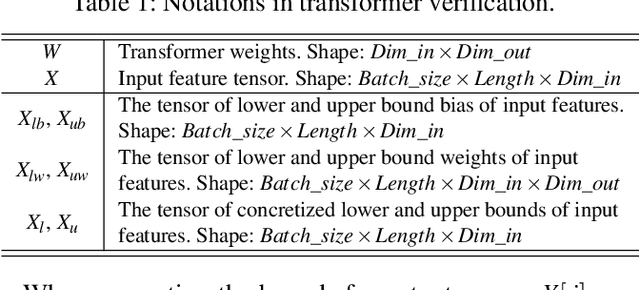
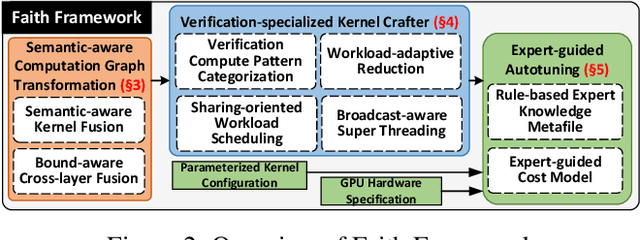

Abstract:Transformer verification draws increasing attention in machine learning research and industry. It formally verifies the robustness of transformers against adversarial attacks such as exchanging words in a sentence with synonyms. However, the performance of transformer verification is still not satisfactory due to bound-centric computation which is significantly different from standard neural networks. In this paper, we propose Faith, an efficient framework for transformer verification on GPUs. We first propose a semantic-aware computation graph transformation to identify semantic information such as bound computation in transformer verification. We exploit such semantic information to enable efficient kernel fusion at the computation graph level. Second, we propose a verification-specialized kernel crafter to efficiently map transformer verification to modern GPUs. This crafter exploits a set of GPU hardware supports to accelerate verification specialized operations which are usually memory-intensive. Third, we propose an expert-guided autotuning to incorporate expert knowledge on GPU backends to facilitate large search space exploration. Extensive evaluations show that Faith achieves $2.1\times$ to $3.4\times$ ($2.6\times$ on average) speedup over state-of-the-art frameworks.
Empowering GNNs with Fine-grained Communication-Computation Pipelining on Multi-GPU Platforms
Sep 14, 2022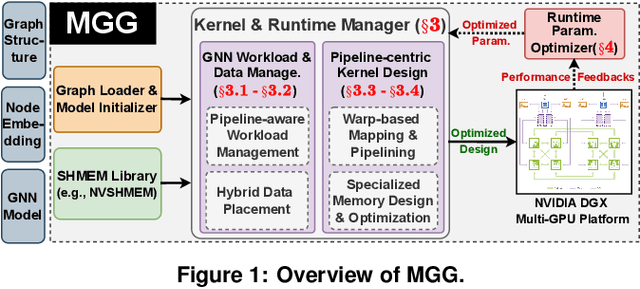

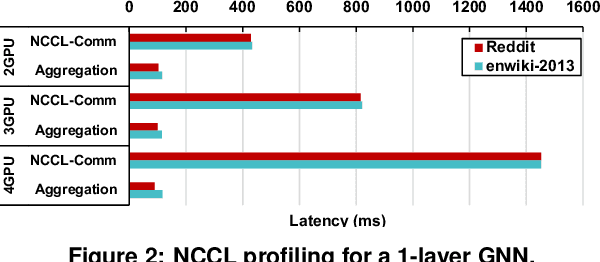

Abstract:The increasing size of input graphs for graph neural networks (GNNs) highlights the demand for using multi-GPU platforms. However, existing multi-GPU GNN solutions suffer from inferior performance due to imbalanced computation and inefficient communication. To this end, we propose MGG, a novel system design to accelerate GNNs on multi-GPU platforms via a GPU-centric software pipeline. MGG explores the potential of hiding remote memory access latency in GNN workloads through fine-grained computation-communication pipelining. Specifically, MGG introduces a pipeline-aware workload management strategy and a hybrid data layout design to facilitate communication-computation overlapping. MGG implements an optimized pipeline-centric kernel. It includes workload interleaving and warp-based mapping for efficient GPU kernel operation pipelining and specialized memory designs and optimizations for better data access performance. Besides, MGG incorporates lightweight analytical modeling and optimization heuristics to dynamically improve the GNN execution performance for different settings at runtime. Comprehensive experiments demonstrate that MGG outperforms state-of-the-art multi-GPU systems across various GNN settings: on average 3.65X faster than multi-GPU systems with a unified virtual memory design and on average 7.38X faster than the DGCL framework.
Biologically Inspired Dynamic Thresholds for Spiking Neural Networks
Jun 09, 2022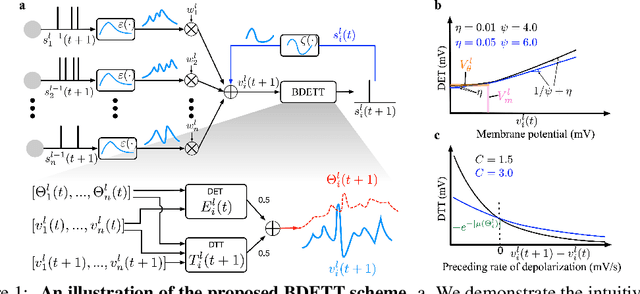
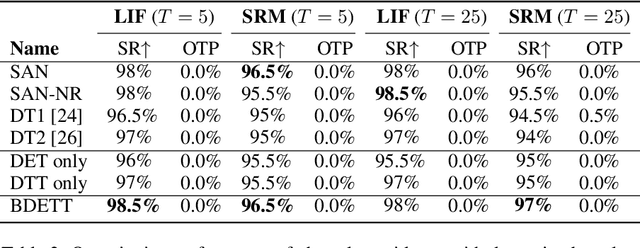
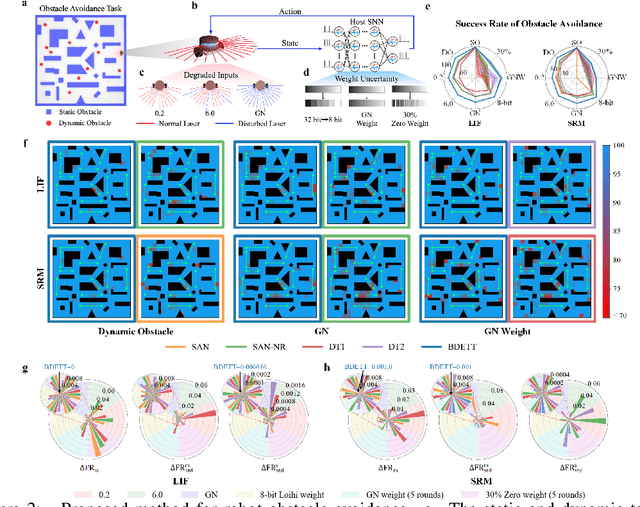
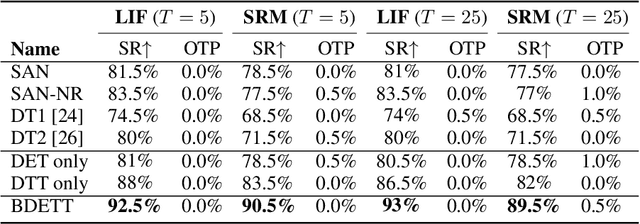
Abstract:The dynamic membrane potential threshold, as one of the essential properties of a biological neuron, is a spontaneous regulation mechanism that maintains neuronal homeostasis, i.e., the constant overall spiking firing rate of a neuron. As such, the neuron firing rate is regulated by a dynamic spiking threshold, which has been extensively studied in biology. Existing work in the machine learning community does not employ bioplausible spiking threshold schemes. This work aims at bridging this gap by introducing a novel bioinspired dynamic energy-temporal threshold (BDETT) scheme for spiking neural networks (SNNs). The proposed BDETT scheme mirrors two bioplausible observations: a dynamic threshold has 1) a positive correlation with the average membrane potential and 2) a negative correlation with the preceding rate of depolarization. We validate the effectiveness of the proposed BDETT on robot obstacle avoidance and continuous control tasks under both normal conditions and various degraded conditions, including noisy observations, weights, and dynamic environments. We find that the BDETT outperforms existing static and heuristic threshold approaches by significant margins in all tested conditions, and we confirm that the proposed bioinspired dynamic threshold scheme offers bioplausible homeostasis to SNNs in complex real-world tasks.
Dynamic N:M Fine-grained Structured Sparse Attention Mechanism
Feb 28, 2022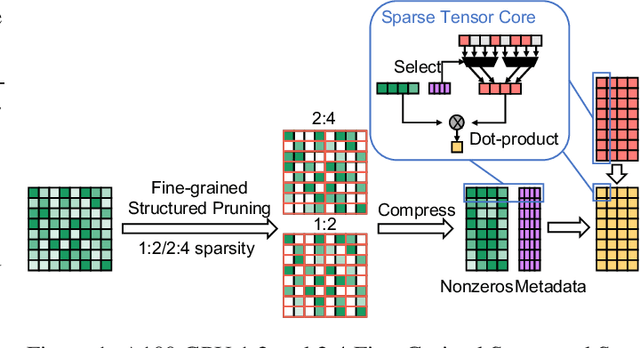

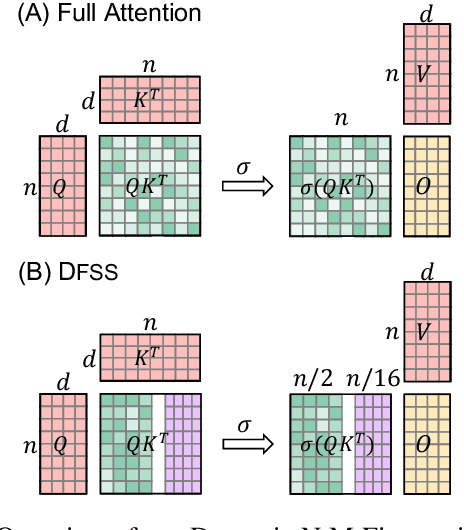

Abstract:Transformers are becoming the mainstream solutions for various tasks like NLP and Computer vision. Despite their success, the high complexity of the attention mechanism hinders them from being applied to latency-sensitive tasks. Tremendous efforts have been made to alleviate this problem, and many of them successfully reduce the asymptotic complexity to linear. Nevertheless, most of them fail to achieve practical speedup over the original full attention under moderate sequence lengths and are unfriendly to finetuning. In this paper, we present DFSS, an attention mechanism that dynamically prunes the full attention weight matrix to N:M fine-grained structured sparse pattern. We provide both theoretical and empirical evidence that demonstrates DFSS is a good approximation of the full attention mechanism. We propose a dedicated CUDA kernel design that completely eliminates the dynamic pruning overhead and achieves speedups under arbitrary sequence length. We evaluate the 1:2 and 2:4 sparsity under different configurations and achieve 1.27~ 1.89x speedups over the full-attention mechanism. It only takes a couple of finetuning epochs from the pretrained model to achieve on par accuracy with full attention mechanism on tasks from various domains under different sequence lengths from 384 to 4096.
Attacking Point Cloud Segmentation with Color-only Perturbation
Dec 18, 2021

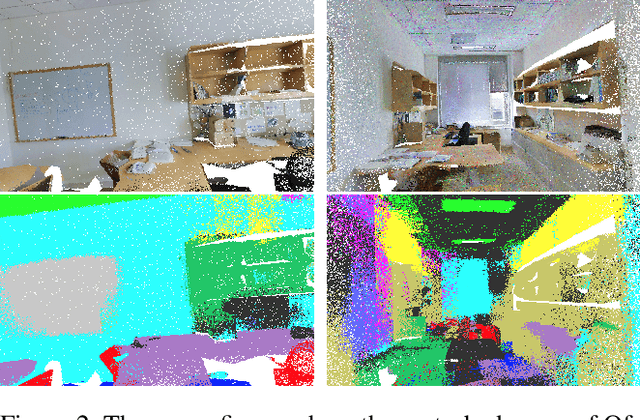

Abstract:Recent research efforts on 3D point-cloud semantic segmentation have achieved outstanding performance by adopting deep CNN (convolutional neural networks) and GCN (graph convolutional networks). However, the robustness of these complex models has not been systematically analyzed. Given that semantic segmentation has been applied in many safety-critical applications (e.g., autonomous driving, geological sensing), it is important to fill this knowledge gap, in particular, how these models are affected under adversarial samples. While adversarial attacks against point cloud have been studied, we found all of them were targeting single-object recognition, and the perturbation is done on the point coordinates. We argue that the coordinate-based perturbation is unlikely to realize under the physical-world constraints. Hence, we propose a new color-only perturbation method named COLPER, and tailor it to semantic segmentation. By evaluating COLPER on an indoor dataset (S3DIS) and an outdoor dataset (Semantic3D) against three point cloud segmentation models (PointNet++, DeepGCNs, and RandLA-Net), we found color-only perturbation is sufficient to significantly drop the segmentation accuracy and aIoU, under both targeted and non-targeted attack settings.
 Add to Chrome
Add to Chrome Add to Firefox
Add to Firefox Add to Edge
Add to Edge